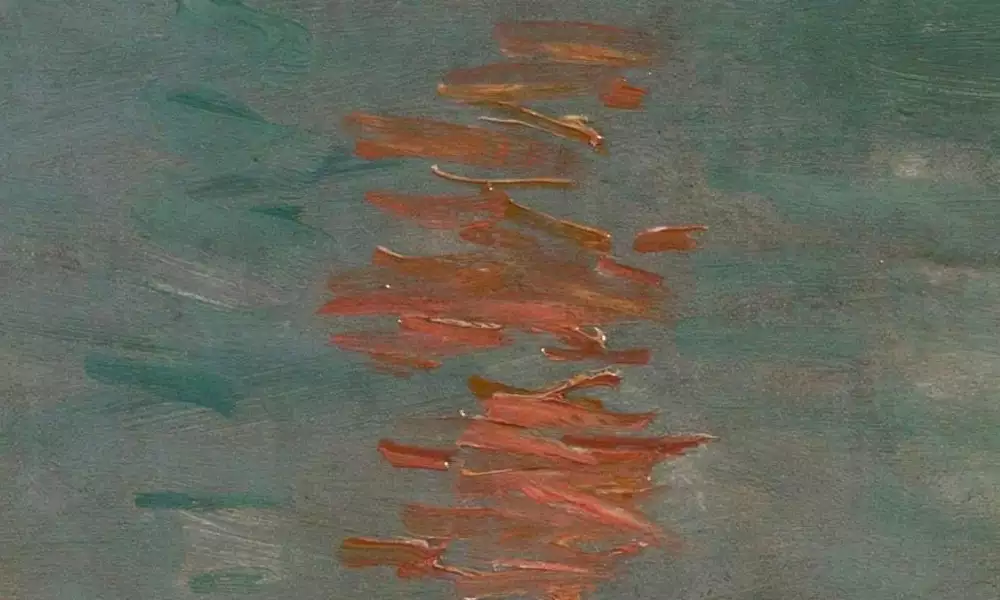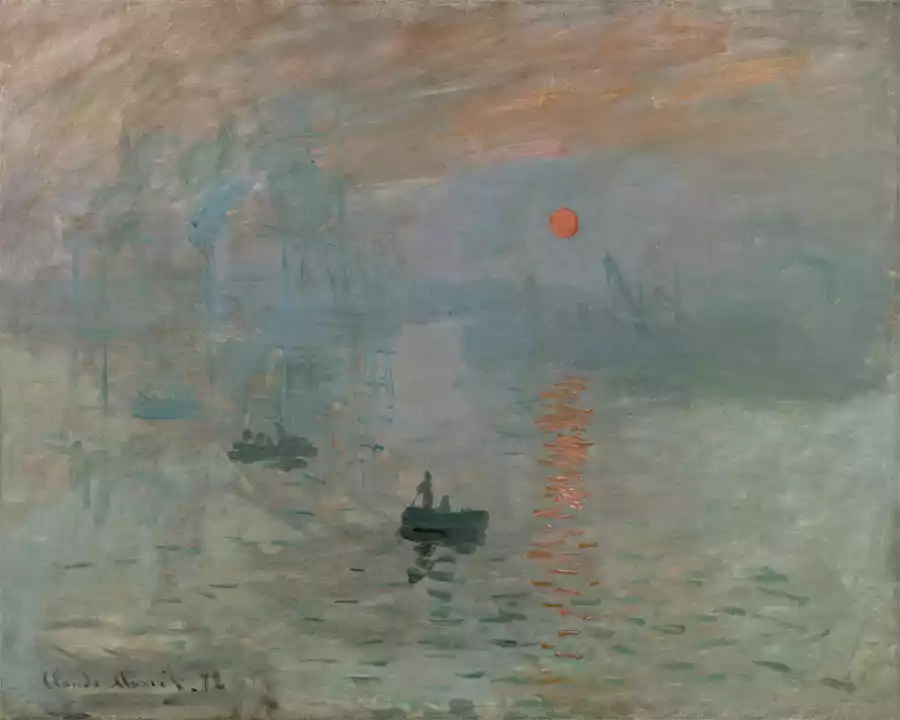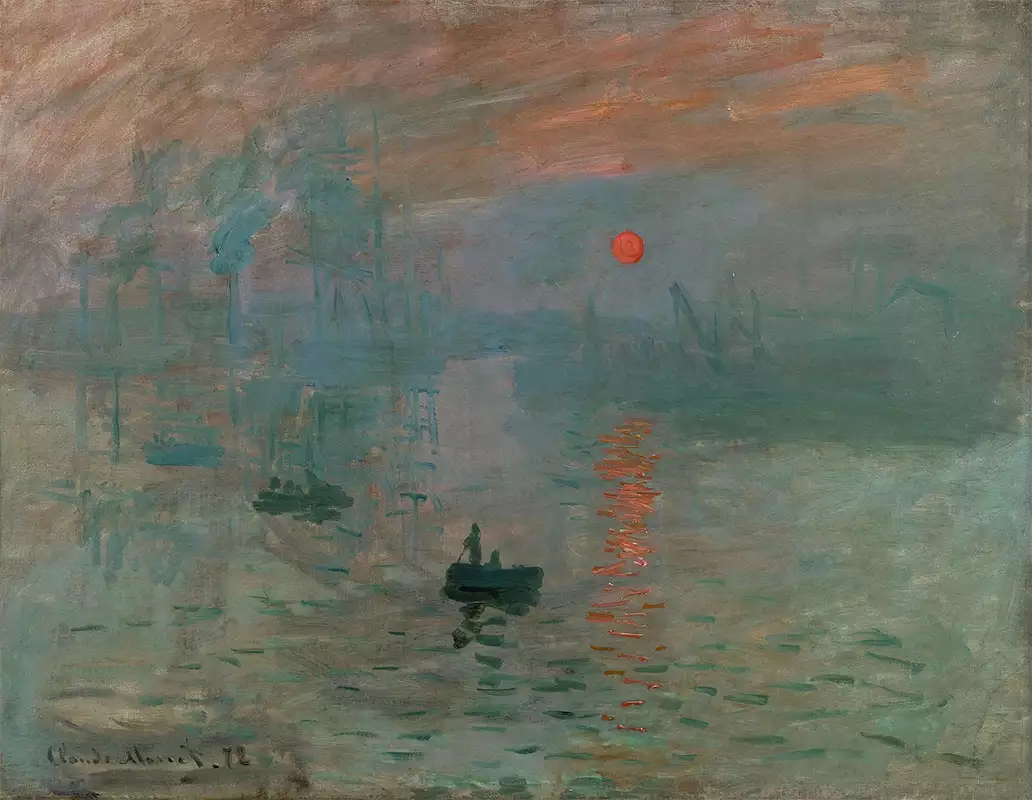Introduction
Few works have marked a milestone in the history of art like Impression, Sunrise by Claude Monet. Painted in 1872 and first exhibited to the public at the 1874 exhibition organized by the Société anonyme des artistes peintres, sculpteurs, graveurs, this work not only defined a new artistic movement but also gave its name to Impressionism, one of the most influential currents in modern art.
This painting is celebrated not only for its revolutionary aesthetics but also for the impact it had on critics and the public of its time. The scene, captured from the window of a hotel at the port of Le Havre, is a synthesis of Monet’s artistic vision: a fleeting study of light, color, and atmosphere that challenges traditional academic techniques and lays the foundations of modern painting.
In this detailed analysis, we will break down every aspect of the work—from its technical characteristics to its iconographic meaning. We will explore its composition, its treatment of light and color, and the way in which Monet managed to capture the fleeting nature of the moment with vibrant, ephemeral brushstrokes. Additionally, we will contextualize the work within the evolution of art and its significance within Impressionism.
Join us on this extensive journey through one of the most emblematic paintings in the history of art.
Technical Data
| Title: | Impression, Sunrise |
| Artist: | Claude Monet |
| Date of Creation: | 1872 |
| Medium: | Oil on canvas |
| Dimensions: | 48 cm × 63 cm |
| Style: | Impressionism |
| Location: | Musée Marmottan Monet, Paris |
Technical Elements
In Impression, Sunrise, Claude Monet employs a revolutionary technique that marked the beginning of the Impressionist movement. This work, executed in oil on canvas, is characterized by its loose and dynamic brushstrokes, as well as its focus on capturing the atmosphere and light at a specific moment of the day. The canvas, modest in size (48 cm × 63 cm), allowed the artist to work quickly—crucial for his purpose of representing the fleeting nature of the sunrise at the port of Le Havre.
The choice of oil as a medium was strategic, as this technique offers great versatility for mixing colors directly on the canvas, achieving subtle nuances and effects of transparency. Monet applied the oil spontaneously, with visible brushstrokes that give the work a vibrant, almost unfinished appearance. These short, intersecting strokes create a texture that reinforces the sense of immediacy and movement. Through this technique, the artist avoided minute details, focusing instead on the overall impression of the scene.
Regarding the treatment of light, Monet departed from traditional methods based on academic chiaroscuro. In this work, light does not emanate from a defined point; rather, it diffuses naturally throughout the canvas. The sun, depicted as a vibrant red disc in the upper center-right, acts as a subtle focal point that bathes the scene in warm tones and reflections on the water. The effects of light and color are achieved through glazes and overlays of pigments that mimic the morning mist.
Another notable technical aspect is the use of color, which in Impression, Sunrise is fundamental for conveying the atmosphere. Monet employs a limited palette dominated by blues, grays, and greens, which contrast with the vibrant oranges and reds of the sun and its reflections. This chromatic combination creates a balance between the cool colors, which evoke a sense of moisture and calm, and the warm tones, which bring dynamism and life to the composition. The use of complementary colors, such as blue and orange, intensifies the visual interaction and emotional impact of the work.
The choice of a relatively small canvas also contributes to the unique character of the work. Monet worked in a small format to quickly capture the effects of light and atmosphere before they changed. This approach was characteristic of the Impressionists, who valued plein air painting and the direct study of nature.
In summary, the technical elements of Impression, Sunrise reflect Monet’s quest to capture the essence of a fleeting moment through an innovative technique and a completely new artistic vision. Every technical decision—from the choice of support and medium to the application of colors and brushwork—contributes to the creation of a work that would revolutionize art forever.
Formal Elements
In Impression, Sunrise, Claude Monet breaks with traditional compositional conventions and presents a scene that appears simple yet is laden with formal innovation. The work is structured asymmetrically, with the main elements distributed in a balanced manner but without rigid symmetry. This approach contributes to the sense of naturalness and spontaneity that characterizes the painting. The focal point, the orange sun in the misty sky, is positioned slightly off-center in the upper right, subtly yet effectively drawing the viewer’s gaze.
The composition is organized into superimposed planes that gradually blur into the background, generating a sense of atmospheric depth. The boats in the water, placed in the foreground, act as visual anchors that guide the viewer’s attention toward the center of the work. At the same time, the port structures and cranes silhouetted on the horizon appear partially hidden by the mist, creating an effect of mystery and remoteness. This treatment of space is characteristic of Impressionism and reflects the influence of the aerial perspective found in Oriental painting, which Monet deeply admired.
The predominant lines in the work are curved and diagonal, which reinforces the sense of movement and fluidity. The gentle undulations of the water and the vertical reflections of the sun contrast with the more static and geometric forms of the cranes in the background, creating a balance between the organic and the structural. This interplay of lines also contributes to the sense of dynamism, as if the scene were in constant transformation under the effects of shifting light.
The background and the foreground integrate fluidly, avoiding abrupt cuts and reinforcing the unity of the scene. This is achieved through the application of colors that blend almost imperceptibly and the absence of defined contours. Instead of clear, delineated lines, Monet uses patches of color to suggest shapes, allowing the viewer’s eye to complete the details.
The scale and proportions of the elements also play an important role. The human figures, schematically represented on the boats, are tiny in comparison to the vastness of the water and the sky. This relationship of sizes underscores the insignificance of man in the face of nature’s grandeur, a recurring theme in Monet’s work.
Finally, the visual rhythm of the work is constructed through the repetition of shapes and reflections. The vertical strokes in the water, reflecting the sun, create a rhythmic pattern that guides the viewer’s gaze toward the background, while the gentle curves of the water and clouds lead the eye from one side of the painting to the other. This slow, organic rhythm reinforces the calm and contemplative atmosphere of the scene.
In conclusion, the formal elements of Impression, Sunrise demonstrate Monet’s ability to combine a balanced composition with an innovative and free approach, generating a work that captures the essence of the moment and lays the groundwork for the development of the Impressionist visual language.
Color
The use of color in Impression, Sunrise is one of the most innovative and characteristic aspects of the work. Claude Monet employs a limited color palette dominated by cool hues such as blues, grays, and greens, which contrast with the vibrant warm tones of the sun and its reflections on the water. This combination not only reinforces the misty and humid atmosphere of the port of Le Havre at dawn but also guides the viewer’s attention to the composition’s focal point: the reddish sun and its projection on the water’s surface.
The interaction between cool and warm colors is essential for generating a visual and emotional balance in the work. The cool tones, which dominate the background and the water, convey a sense of calm, serenity, and distance. On the other hand, the orange and red of the sun provide energy and drama, acting as a visual contrast that breaks the monotony of the landscape. This contrast also creates a dialogue between the fleeting nature of the dawn’s light and the stillness of the surroundings, capturing the ephemeral essence of the moment.

The treatment of color in this work is equally innovative. Monet applies the pigment with quick, loose brushstrokes, allowing the colors to blend optically rather than directly on the palette. This technique creates smooth transitions between different hues and generates a sense of luminous vibration, as if the scene were alive and in constant change. The horizontal and vertical brushstrokes in the water reflect the colors of the sky and the sun, integrating all the elements of the composition into a harmonious whole.
Another notable aspect is the absence of defined contours. Instead of precisely outlining shapes, Monet uses patches of color to suggest them, allowing atmosphere and light to become the true protagonists of the work. This reinforces the idea that the painting is not intended to be a literal representation of reality, but rather a subjective interpretation of the visual impression it creates.
The color range also plays an important role in constructing spatial depth. The darker, more saturated tones are found in the foreground, while the lighter, desaturated colors are used in the background, creating an effect of atmospheric perspective. This technique, combined with the reflections and mist enveloping the scene, gives the impression that the port extends infinitely toward the horizon.
In symbolic terms, the use of color in Impression, Sunrise also has a significant impact. The reddish sun can be interpreted as a symbol of renewal and hope, while the cool tones of the water and sky reflect the melancholic calm of dawn. This chromatic duality, which combines energy and tranquility, defines not only the atmosphere of the work but also the essence of Impressionism as a movement that celebrates life in its fleeting, everyday beauty.
Treatment of Light
The treatment of light in Impression, Sunrise is one of the most distinctive and revolutionary elements of the work, reflecting Claude Monet’s intention to capture the fleeting nature of a moment. Unlike traditional academic chiaroscuro techniques, where light is used to model volumes realistically, Monet presents a scene bathed in a diffuse and enveloping light, which becomes the undisputed protagonist of the composition.
The light in this work is natural and emanates from the rising sun that dominates the upper center-right of the scene. This small reddish disc emits a warm glow that contrasts with the bluish mist enveloping the port. Despite being an obvious light source, the sun does not illuminate the scene uniformly; rather, the light seems to filter through the morning fog, creating an atmospheric effect that suggests moisture, cold, and the awakening of the day.
One of the most notable aspects is how Monet represents the reflections of light on the water’s surface. The vertical orange brushstrokes, which mimic the sun’s reflection, not only add dynamism to the composition but also contribute to the depth and sense of movement in the work. These reflections blend with the darker, subdued tones of the water, creating a contrast that highlights the luminosity of dawn.
Monet uses light not only to illuminate but also to blur the contours of forms, achieving an ethereal atmosphere. The port structures, cranes, and boats seem to emerge from the mist, as if partially hidden by a veil. This effect not only adds mystery to the scene but also reflects the influence of aerial perspective, a technique that the artist elevated in his quest to capture the atmosphere.
It is important to note that the light in this work is not limited to being a descriptive element; it also plays an emotional role. The way it diffuses throughout the composition suggests a sense of calm and melancholy, typical characteristics of dawn. This choice emphasizes the ephemeral nature of the moment Monet sought to capture, inviting the viewer to contemplate the fleeting beauty of the beginning of the day.
Furthermore, the light in Impression, Sunrise serves as a vehicle to explore the relationship between color and atmosphere. Monet does not aim for an objective representation of light; instead, he focuses on how it interacts with the surroundings, transforming colors and forms. This experimental approach would become a hallmark of Impressionism, influencing generations of artists to come.
Space
The treatment of space in Impression, Sunrise is an essential component that reinforces the atmosphere and depth of the scene. Monet manages to create a fluid and enveloping space through innovative techniques that depart from traditional academic representations, focusing on capturing the visual experience of perception rather than an exact reproduction of reality.
In this work, space is constructed through the superposition of planes that gradually blur into the background. The boats in the foreground are rendered with greater contrast and clarity, while the port structures and cranes in the background are enveloped in a dense mist that softens their outlines. This effect of aerial perspective, inspired by techniques from Eastern painting, provides a sense of remoteness and depth, guiding the viewer through the composition.
The water, which occupies most of the canvas, plays a fundamental role in creating the space. Its surface acts as a mirror that reflects the sunlight and the shadows of the boats, establishing a visual connection between the different planes. The horizontal, undulating brushstrokes suggest movement, while the vertical reflections of the sun on the water add a sense of depth that anchors the composition.
Monet avoids the use of a rigid linear perspective typical of Renaissance painting, opting instead for a freer, more intuitive representation of space. This is reflected in the arrangement of the elements, which do not follow an exact geometric scheme but are organized in a way that conveys the impression of a scene captured in an instant. This dynamic representation of space contributes to the sense of immediacy and spontaneity that characterizes the work.
Another key resource in constructing the space is the handling of light and color. The darker, more saturated tones concentrate in the foreground, while the lighter, desaturated colors dominate the background. This tonal transition reinforces the atmospheric depth, making the more distant elements seem to dissolve into the morning mist. This approach not only defines the physical space but also captures the atmosphere of dawn, turning space into an emotional component of the work.
It is important to emphasize that the space in Impression, Sunrise is not static but charged with movement. The dynamic brushstrokes and the vibrant textures of the water, along with the blurred shapes of cranes and smokestacks rising on the horizon, create the sensation of a living, ever-changing environment. This kinetic quality of space reinforces the central idea of the work: to capture a fleeting moment in its entirety, from the atmosphere to the energy of the port.
Iconographic Analysis
The iconographic analysis of Impression, Sunrise allows us to understand not only the content represented in the work but also its cultural, historical, and symbolic context. In this painting, Claude Monet captures an apparently everyday scene: the sunrise over the industrial port of Le Havre, his hometown. However, this thematic choice transcends mere description, as it reflects the spirit of an era marked by modernity, industrial progress, and changes in artistic perception.
The port of Le Havre, depicted in the work, was a symbol of France’s economic development during the 19th century. In the painting, cranes, factory chimneys, and steamships serve as emblems of the industrialization that was transforming cities and landscapes. Rather than focusing on the negative aspects of industrialization, such as pollution or dehumanization, Monet opts for a perspective that celebrates the interaction between man and nature, highlighting how light and atmosphere can transform even the most utilitarian elements into something beautiful and poetic.
The rising sun, the central element of the composition, carries a symbolic meaning that transcends its naturalistic function. In many cultures, dawn is associated with renewal, hope, and the beginning of a new cycle. In the context of this work, the sun appears to allude to the birth of a new form of art—Impressionism—which sought to break with academic traditions and explore new ways of representing the world.
The choice of the title, Impression, Sunrise, also carries significant iconographic weight. At the time of the exhibition, Monet was not aiming to describe the exact location or the specific content of the scene, but rather the sensation it conveyed. This subjective and intuitive approach reflected the core of Impressionism: to capture the fleeting impression of a moment and allow the viewer to complete the details through their own visual experience.
More broadly, the work can be interpreted as a meditation on the relationship between man and nature in a changing world. The human figures, schematically depicted in the small boats, appear tiny and insignificant in the vastness of the port and sky. However, these figures are not absent from the scene; their presence suggests a balance between human activity and the natural environment, a recurring theme in Monet’s work.
The historical context is also relevant for understanding the iconography of the work. Painted in 1872, just after the Franco-Prussian War (1870–1871), Impression, Sunrise can be interpreted as a reflection of France’s resilience following the conflict. The rebuilt and active port of Le Havre symbolizes economic recovery and the optimism of a nation looking to the future.
Conclusion
Impression, Sunrise not only marked the beginning of the Impressionist movement but also revolutionized the way we understand and experience art. Through its innovative use of color, light, space, and composition, Claude Monet managed to capture the essence of an ephemeral moment, inviting the viewer to be part of a unique sensory and emotional experience. Beyond being a mere representation of the sunrise at the port of Le Havre, the work stands as a visual manifesto of modernity, artistic exploration, and the transformative power of creativity. Its impact transcends the context of its creation, establishing itself as a milestone in art history that continues to inspire and challenge contemporary generations.

Impression, Sunrise – Claude Monet
Immerse yourself in the enchanting world of *Impression, Sunrise*, a masterpiece of Impressionism that captures the delicate interplay of light and water. Created in 1872, this artwork showcases Monet’s innovative approach to colour and form, where soft brushstrokes blend shades of blue, green, and warm hues of pink and orange. This reproduction, available as a print or on canvas, invites you t…

